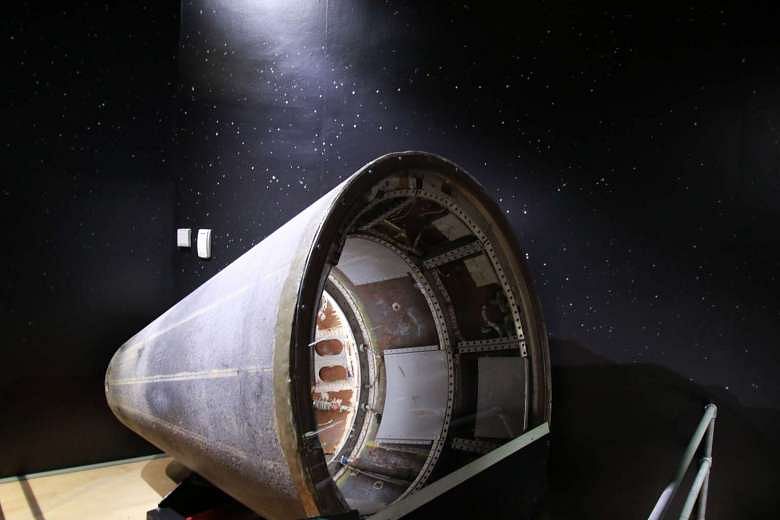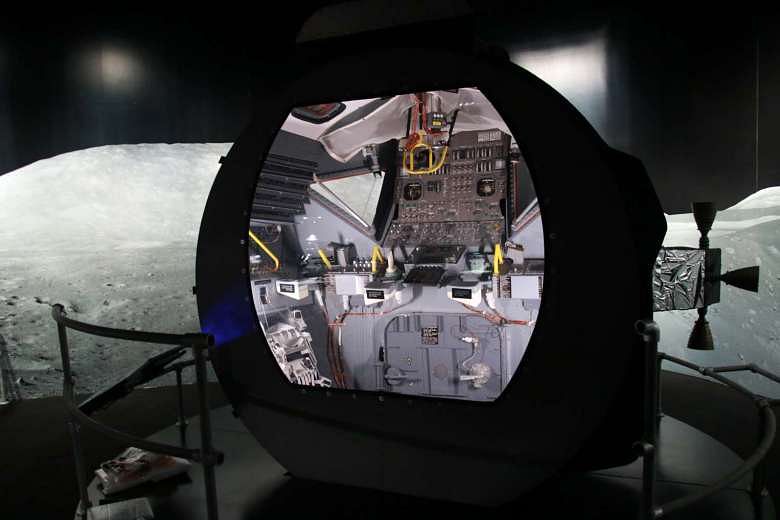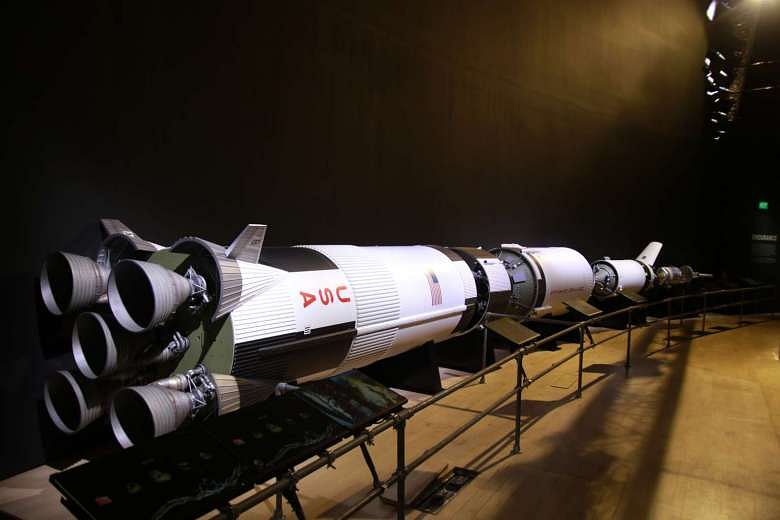See space artefacts at exhibition
Exhibition on space exploration will display 200 artefacts from the American and Russian space programmes









If you have ever wondered why outer space has been so fascinating for mankind, the largest space flight exhibition in Singapore will feed some of that curiosity.
Nasa - A Human Adventure, which runs at the ArtScience Museum till March next year, boasts more than 200 artefacts from the American and Russian space programmes, with space- flown items as well as full-scale replicas of spacecraft and paraphernalia on display.
Nasa stands for the National Aeronautics and Space Administration, the United States' space agency.
The majority of the exhibits are on loan from the Kansas Cosmosphere and Space Center and the U.S. Space & Rocket Center in Alabama. The exhibition also details Nasa's accomplishments in space exploration and the space race between the US and Soviet Union during the Cold War.
The museum has organised one-hour guided tours for the public to discover the story of space exploration and man's innovations in the field. Families can check out the hour-long Space Quest workshops, where participants can design space mission patches for spacesuits and learn about spatial awareness.
Created by Dutch company John Nurminen Events in 2010, the show has travelled to nine countries, including Sweden and South Korea. The Straits Times looks at some of the exhibition's highlights.
10 highlights of Nasa exhibition
1 JUPITER ROCKET NOSE CONE

This space-flown nose cone of a Jupiter rocket was retrieved from the Atlantic Ocean. According to Mr Jukka Nurminen, chief executive of John Nurminen Events and the exhibition's curator, an American couple walking on the shore in Florida found it.
The nose cone is one of the first to use a heat shield developed from ceramic to protect the tip of the rocket from the large amount of heat generated upon re-entry into the Earth's atmosphere. These temperatures were known to reach above 1,000 deg C.
2 SPACE FOOD

Unsurprisingly, space food does not look appetising. They are practical almost to a fault. Bread cubes form the carbs of a day's meal, coffee comes in a tube and mashed potato in cans.
The types of food reveal the differences between the American and Russian diets. Bacon and apple sauce were provided on the Apollo space missions, while Russian meals included borscht (sour soup) with meat, pork goulash (stew) and vodka.
3 SPACE-THEMED VINTAGE TOYS

In an exhibition with replica spacecraft and space-flown artefacts, toys might seem lightweight in comparison. But these vintage space-themed toys provide a glimpse of what it was like to grow up in an era when space exploration was new and exciting. Millions of people would follow the missions on radio and television and astronauts were seen as national heroes.
4 APOLLO AND SKYLAB A7LB SPACESUIT

Apollo astronauts wore spacesuits which had to protect them from the harsh environment on the moon and allow enough mobility and flexibility for them to carry out activities in that environment.
The suit consists of 11 layers, including a cooling and ventilation garment against the skin, inner layers of nylon, polymer-based films such as Kapton and Mylar, and a protective outer layer of Teflon-coated fibreglass cloth.
Under normal gravity conditions on Earth, this suit - along with accompanying gloves, boots, a helmet and life support backpack - would weigh 91kg.
5 SPACE SHUTTLE REPLICA
Do not miss this full-scale replica of the double-storey crew cabin and forward fuselage of the United States' Space Shuttle. The orbital spacecraft, which was the first to be able to transport cargo to space and back, was in operation between 1981 and 2011.
It was the world's first partially reusable spacecraft, with an orbiter vehicle which could land like an airplane and be used multiple times. It could carry up to eight crew members and also helped in the construction and maintenance of the International Space Station, a satellite in space used for research purposes which was launched in 1998.
6 REPLICA OF APOLLO LUNAR MODULE CREW CABIN

This full-scale replica resembles an airplane's cockpit.
As the landing portion of the Apollo spacecraft, the Lunar Module is designed to bring a crew of two astronauts from lunar orbit to the moon and back, before being discarded in outer space. A third crew would remain in orbit. Between 1969 and 1972, six Lunar Modules landed successfully on the moon.
In 1970, astronauts on the Apollo 13 mission used the seventh Lunar Module as a life-support system when an oxygen tank explosion derailed their mission. Using it for propulsion, all three crew members returned safely to Earth.
7 SATURN V SCALE MODEL

The Saturn V is a launch vehicle that was developed to support the Apollo missions. It was used by Nasa actively between 1966 and 1973. At 110.6m tall and weighing 2,950 tonnes when fully fuelled, Saturn V is the tallest and heaviest rocket to date. It is also the only launch vehicle with enough power to carry humans to the moon and back.
8 MERCURY CAPSULE REPLICA

This is a full-scale replica of a capsule from the Mercury spacecraft - the first human space-flight programme for the US that ran from 1958 to 1963. During the Cold War, the US and the then Soviet Union were engaged in a race to put the first man in space and on the moon. The Mercury spacecraft was designed to carry one man to space for a day and was the US's first step to putting a man in space. It paved the way for later space technology that could carry heavier loads for longer periods.
9 V-2 MISSILE FRAGMENTS

These space-flown fragments may not be much to look at, but represent an important part of history as the progenitor of the modern rocket.
The V-2 rocket was the world's first long-range ballistic missile which was developed by the Germans during World War II. The creators, including lead engineer Wernher von Braun, joined the US Army's missile programme and later Nasa.
Von Braun was an important figure in early American space programmes, helping to create the most powerful rocket to date, the Saturn V rocket, for the US.
10 APOLLO 12 FILM FRAMES AND FILM MAGAZINES

Swedish-made Hasselblad cameras were used by Nasa for lunar space photography. However, only the film magazines were brought back to Earth as the camera bodies and lenses had to be discarded on departure to save weight. The film magazines on display have been to the moon and back on the Apollo 8, 12 and 17 missions.
BOOK IT / NASA - A HUMAN ADVENTURE
WHERE: ArtScience Museum, Marina Bay Sands, 10 Bayfront Avenue
WHEN: Till March 19, 10am to 7pm daily
ADMISSION: $15 to $25 (adults), $9 to $15 (children)
INFO: marinabaysands.com/ArtScienceMuseum
BOOK IT / PUBLIC GUIDED TOURS
WHERE: Exhibition entrance, Basement 2, ArtScience Museum
WHEN: English tours - today and Dec 30, 3pm; Sunday and Dec 25, 11.30am; Mandarin tours - Sunday and Dec 25, 2 and 4pm
ADMISSION: Complimentary for exhibition ticket-holders. Open only to the first 25 participants
BOOK IT / SPACE QUEST WORKSHOP
WHERE: Rainbow Room, Basement 2, ArtScience Museum
WHEN: Today and Dec 30, 4.30pm
ADMISSION: $8 a person. Open only to the first 20 participants
Join ST's Telegram channel and get the latest breaking news delivered to you.
A version of this article appeared in the print edition of The Straits Times on December 16, 2016, with the headline See space artefacts at exhibition . Subscribe

